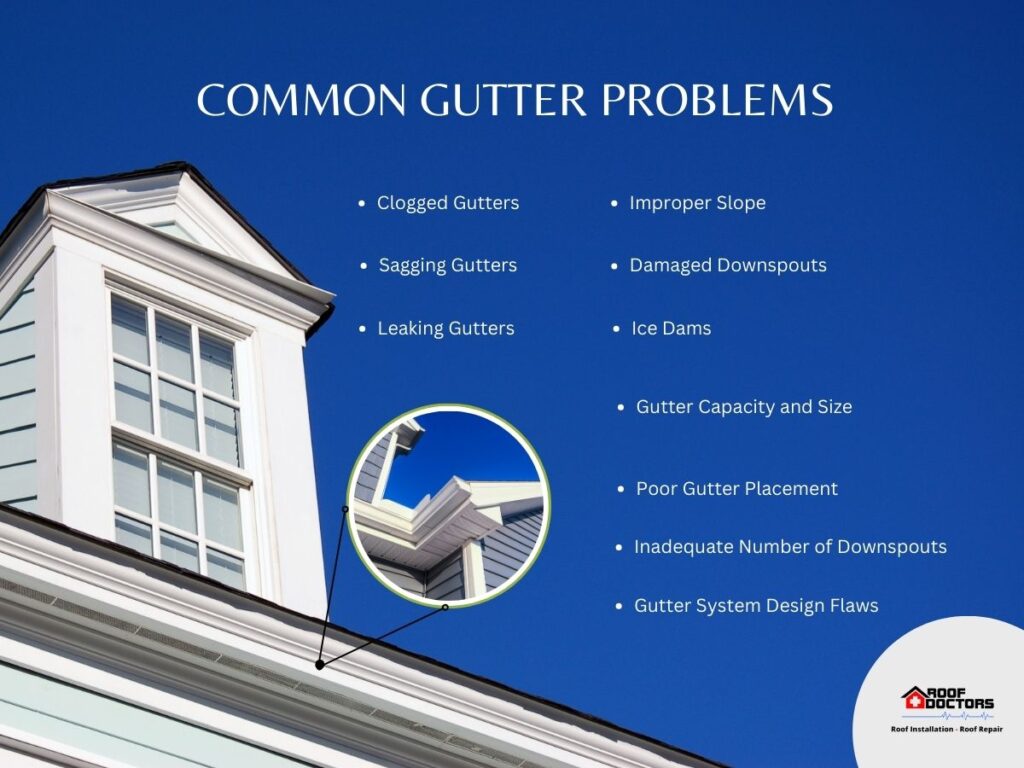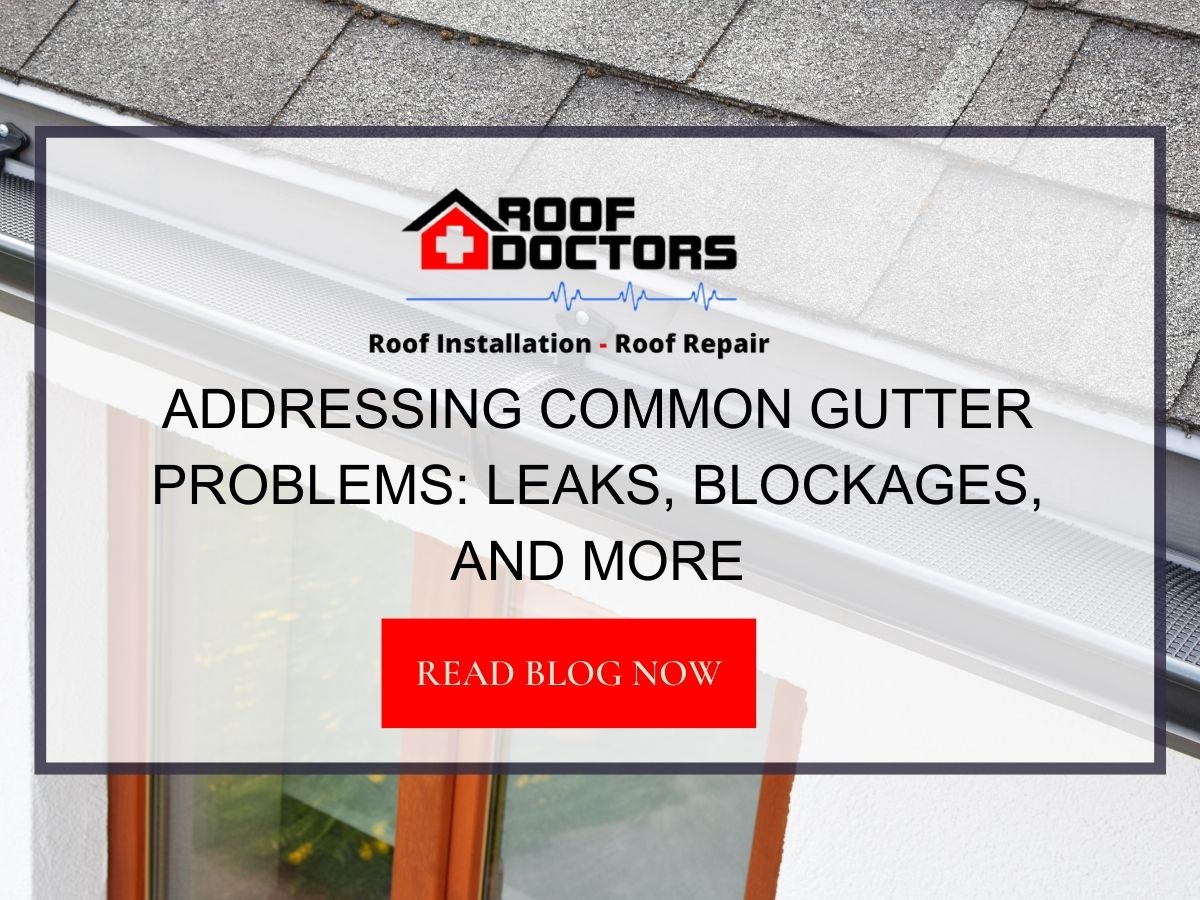Addressing common gutter problems is integral to any building’s exterior, serving as the first line of defense against water damage. They channel rainwater away from the structure, protecting the roof, walls, foundation, and landscape from the harmful effects of water accumulation.
Gutters play an important function in protecting the structural integrity of your home or business, yet they are often ignored and neglected. This article will be addressing common gutter problems, their potential consequences, and the solutions to address them.
By understanding and addressing common gutter problems, you can ensure that they continue to function effectively, safeguarding your property from the damaging effects of uncontrolled rainwater.
Clogged Gutters
Problem:
One of the most common gutter problems is clogging. Leaves, twigs, and other debris can accumulate in gutters, obstructing the flow of water and causing it to overflow. This can lead to water damage to the building’s siding, roof, and foundation.
The last thing you want is your siding or windows to get water damage. It goes from a simple fix (your gutters) to an expensive siding or window replacement. We have seen this time and time again, and if it is left unchecked over a number or years the damage is done!
Alex Motron | Owner of Best Exteriors a Window & Siding Replacment Company in Sacramento/ Bay Area
Solution:
Regular cleaning is the best way to prevent clogged gutters. At least twice a year, ideally in the spring and fall, clear up the gutters of any debris that may have accumulated. To clean it up, you’ll need a ladder, some gloves, and a scoop or a garden trowel. Another option is to use a high-pressure nozzle attached to a hose to flush the mess away. If you want to protect leaves and other debris from becoming stuck in your gutters, installing gutter guards is a good idea.
Sagging Gutters
Problem:
Over time, gutters may start to sag or pull away from the fascia board. This can be caused by the weight of accumulated debris, water, or ice or the deterioration of the gutter hangers.
Solution:
Inspect the gutter hangers and brackets for signs of wear or damage. Replace any damaged or missing hangers.
Additionally, to ensure proper gutter support, keep the hangers spaced no more than 24 inches apart. If the gutters are still sagging, try moving or adding more hangers.
Leaking Gutters
Problem:
Leaks can occur at the seams, corners, or joints of the gutters or through holes or cracks in the gutter material. Leaking gutters can cause water to drip onto the siding, windows, or foundation, leading to water damage and mold growth.
Solution:
Inspect the gutters for signs of leaks, such as rust, holes, or cracks. Clean the affected area and apply a gutter sealant or caulk to seal the leak. If the leak is at a seam or joint, you may need to disassemble the joint, clean it, and reassemble it with a fresh application of sealant.
You may need to patch the gutter with a piece of metal flashing or a gutter repair kit for larger holes or cracks.
Improper Slope
Problem:
We should slope the gutters slightly towards the downspouts to ensure proper drainage. If we don’t slope the gutters correctly, they might accumulate water, causing clogging, sagging, and rusting.
Solution:
Use a level to check the slope of the gutters. The gutters should slope at least 1/4 inch for every 10 feet of length. Adjust the hangers or brackets to create the proper slope if the slope is insufficient. You may need to reinstall the gutters if they are severely out of level.

Damaged Downspouts
Problem:
Damages, clogs, or disconnections in downspouts can also occur, hindering the redirection of water away from the building.. This can lead to water pooling around the foundation, causing soil erosion and foundation damage.
Solution:
Inspect the downspouts for signs of damage, such as dents, holes, or rust. Repair or replace any damaged sections. The downspouts must be fastened firmly to the gutters and must extend no less than five feet away from the building’s base.
Use downspout extensions or splash blocks to direct water further away from the foundation. Clean the downspouts regularly to prevent clogging.
Ice Dams
Problem:
Ice dams can form in the gutters in cold climates, preventing water from draining. The ice can cause the gutters to sag, leak, or become detached from the fascia board.
Solution:
Maintaining a well-insulated and ventilated attic can help stop ice dams from forming. This will help prevent warm air from escaping through the roof and melting the snow, which can then refreeze in the gutters.
Install heat tape or heating cables in the gutters to melt the ice. If ice dams have already formed, use a roof rake to remove snow from the roof and break up the ice in the gutters.
Gutter Capacity and Size
Problem:
Gutters that are too small for the roof area they serve may be unable to handle the water flowing off the roof during heavy rain. This can result in overflowing gutters, which can lead to water damage to the siding, foundation, and landscaping.
Solution:
Ensure that your gutters are appropriately sized for your roof. The size of the gutters needed depends on the roof area, the pitch of the roof, and the maximum rainfall intensity in your area. In general, 5-inch K-style gutters or 6-inch half-round gutters are suitable for most residential homes.
However, larger roofs or roofs with a steep pitch may require 6-inch K-style gutters or larger ones. Consult a professional gutter contractor if you’re unsure about the appropriate size for your gutters.
Poor Gutter Placement
Problem:
Gutters that are not properly placed can cause water to flow in the wrong direction, leading to leaks, erosion, and foundation damage. Gutters should be installed to catch all the water flowing off the roof and direct it to the downspouts.
Solution:
Make sure the gutters are installed in the right spots and are level. They should be positioned directly under the eaves to collect rainwater as it runs off the roof. For optimal drainage, the gutters should be slanted ever-so-slightly toward the downspouts. You may need to realign or reinstall the gutters if they are not in the right spots.
Inadequate Number of Downspouts
Problem:
Insufficient downspouts can lead to poor drainage and overflowing gutters. This can result in water damage to the siding, foundation, and landscaping.
Solution:
Ensure that you have an adequate number of downspouts for your gutter system. Generally, there should be one downspout for every 20 to 30 feet of gutter. The size and shape of your roof and the amount of rainfall in your area may also affect the number of downspouts needed. If you have too few downspouts, consider adding more to improve drainage.
Gutter System Design Flaws
Problem:
A poorly designed gutter system can cause many problems, including poor drainage, overflowing gutters, and water damage. It is important that the gutter system be able to collect and safely discharge the amount of water expected to run off the roof.
Solution:
Check that your gutters are the right size for your structure. Gutter placement and size, as well as downspout number, should be carefully considered.
The downspouts should direct water at least 5 feet away from the foundation. If your gutter system is poorly designed, you may need to consult a professional gutter contractor to redesign and reinstall it.
Final Words
Addressing common gutter problems is crucial for your property’s overall health and longevity. Gutters play a vital role in protecting your home or building from water damage, soil erosion, and foundation issues.
However, they can become a source of problems if not properly maintained. Clogged gutters, sagging gutters, leaking gutters, improper slopes, damaged downspouts, ice dams, and other issues can all have serious consequences for your property.
Regular maintenance, proper installation, and timely repairs are key to preventing and addressing common gutter problems. By taking proactive steps to keep your gutters in good working condition, you can protect your property from the damaging effects of uncontrolled rainwater and avoid costly repairs.
It may be best to consult a professional gutter contractor if you are unsure how to address a particular gutter problem or if it is severe.


